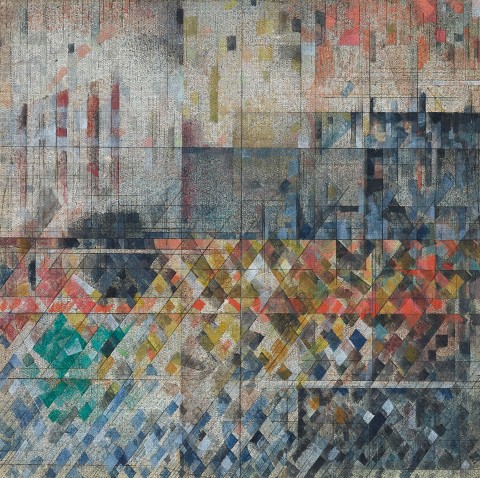CITYSCAPE, c.1950 – 1952
GODFREY MILLER
oil on canvas on compressed card
35.0 x 35.0 cm (image)
33.5 x 33.0 cm (sight)
bears inscription lower right in the tacking margin: JH 134
label attached verso signed by J. Henshaw, executor of the artist's estate
Estate of the artist, Sydney
John Lockhart AO, Sydney
Joseph Brown Gallery, Melbourne
Private collection, Melbourne, acquired from the above in 1981
Joseph Brown Gallery, Melbourne, 10 – 24 September 1981, cat. 140 (illus. in exhibition catalogue)
While Godfrey Miller was held in high regard amongst modernist painters of his time, an aversion to exhibiting, or releasing his works from the studio stunted the arc of his career during his lifetime. Most of Miller’s major works are held in institutions, as he was reluctant to sell to private collectors, except on rare occasions for important individuals whom he felt worthy of owning his works.
Miller’s paintings represent the true spirit of an artist whose sole focus in life was the pursuit of truth and beauty through his work. His mature paintings are characterised by his use of fine, ruled lines, which segment the surface into small geometric fields poised to receive pockets of pigment. The artist’s working methods were such that it may have felt impossible for Miller to actually finish a painting. His forensic attention to detail meant that each additional application of colour, no matter how minor, would send a kaleidoscopic ripple across the work, which the artist would intuitively be required to follow with further strokes and counter strokes, resulting in a perpetual game of aesthetic adjustment. From early in his career, Miller was known to take up to fifteen years to complete a painting.
The current work Cityscape, c. 1950 – 52, is a square format which the artist has divided neatly in half using a direct horizontal line across the centre of the work. This bold gesture for Miller which displays a neat, formal division is not often apparent in Miller’s meditations on nature versus mathematics. In this case the strategy suits the subject very well as it allows him to divide the ‘landscape’ into two equal contrasting parts. The lower half of the work features Miller’s mature geometric style, which is rich in detail and colour and alludes to a natural world. Whereas the upper half of the work features a series of vertical forms, which when read in conjunction with the grey tones suggest a manmade environment of a city with industrial overtones.
Miller has often drawn parallels between trees and architecture. In his endless quest for unity between subject, ground and medium, Miller developed a method of weaving and layering his subjects with the surrounding space. Through a merging natural and manmade forms, he succeeded in creating works of enormous technical complexity. The artist has left Cityscape, poised perfectly between representation and near abstraction.
From the early 1950s onwards, Miller’s work sat in contrast to the lyrical abstraction which prevailed through the teaching at East Sydney Technical College. While the influential John Passmore and his students danced to the tune of Cézanne, Godfrey Miller stayed true to his intuition: his rigid analytical propositions representing not only a milestone of Australian painting, but a profoundly personal vision.
HENRY MULHOLLAND
